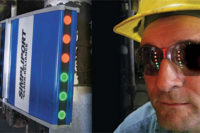Even though we are in the heating season, it is an important time for good housekeeping and knowing where to find information. This article will offer boiler operators and maintenance personnel helpful information regarding their water level indicators.
Check your boiler room and the area surrounding the boiler for the following:
- Items that may have been stored or left behind from repairs that are too close to the boiler, including tools, lubricants, and debris.
- Inspect any externally mounted piping and valves for any signs of leaks and remedy the situation before it gets worse.
- Look for signs of missing insulation, which may have been temporarily removed for maintenance or inspection. You may also discover areas where additional insulation could be installed to improve safety for your plant personnel.
- If you have any heat tracing installed, be certain it is in working order. Some of our readers may have recently installed heat tracing, especially after the deep freeze that occurred in the southern states in 2021.
- Check that all level-indicating instruments are easy to read and the related drain piping is in good order and safely installed with the discharge away from the operator.
It is vital to ensure all level indication instruments are in good working order with the illumination accessories attached, as needed. Typically, tubular glass on low-pressure boiler applications is easy to read, but signs of wear may include staining at the normal operating level or if a worn, “white chalk” color may appear and hinder the reading. If these symptoms are observed on any type of gage glass, it should be promptly serviced. On transparent, flat glass or ported-type gages that require the aid of illumination to enable operator viewing of the water level, the illumination accessories must be kept in good working order. It is vital to have the illumination accessories attached to ported gages as shown in Figure 1 to view the level. The best test for viewing the water level is to position oneself where he or she is expected to read the instrument and to be able to do so.
If a water gage glass appears to be contaminated, the first logical attempt to clean it would be completed through a blowdown of the gage. This procedure flushes the gage in effort to internally clean it. If it is successful, the gage can be returned to service. If not, the gage is likely in need of a rebuild or complete replacement.
Use of the original gage manufacturer’s instruction manual should be the ultimate guide for this item. Keeping a log to record maintenance on level gages will help you track the service life and minimize your cost. It can also be used as an aid for planning future maintenance intervals on these instruments in your plant.
Remote level indicator systems and low water level switches commonly include sensing components consisting of conductivity probes or floats. The method of testing is also with a blowdown. It is important to note that all plant procedures must be followed before conducting any testing or maintenance. If more involved diagnostics are needed, consult with the OEM for accurate information. Most major manufacturers have detailed instruction manuals readily available on their websites.
For more helpful insight, see the proper care recommendations in the American Society of Mechanical Engineers (ASME) Boiler and Pressure Vessel Code. Specifically, Section VI for heating boilers constructed to Section IV that operate up to 15 psi and hot water supply boilers not exceeding 160°F and Section VII for other power boilers. The information in these documents includes many details for startup, operations, and maintenance of these boiler applications in a concise manner. Finally, any concerns regarding your boiler installation should be directed to your insurance carrier or local jurisdiction inspection authority.
By Jim Kolbus, senior product manager for Clark-Reliance LLC



